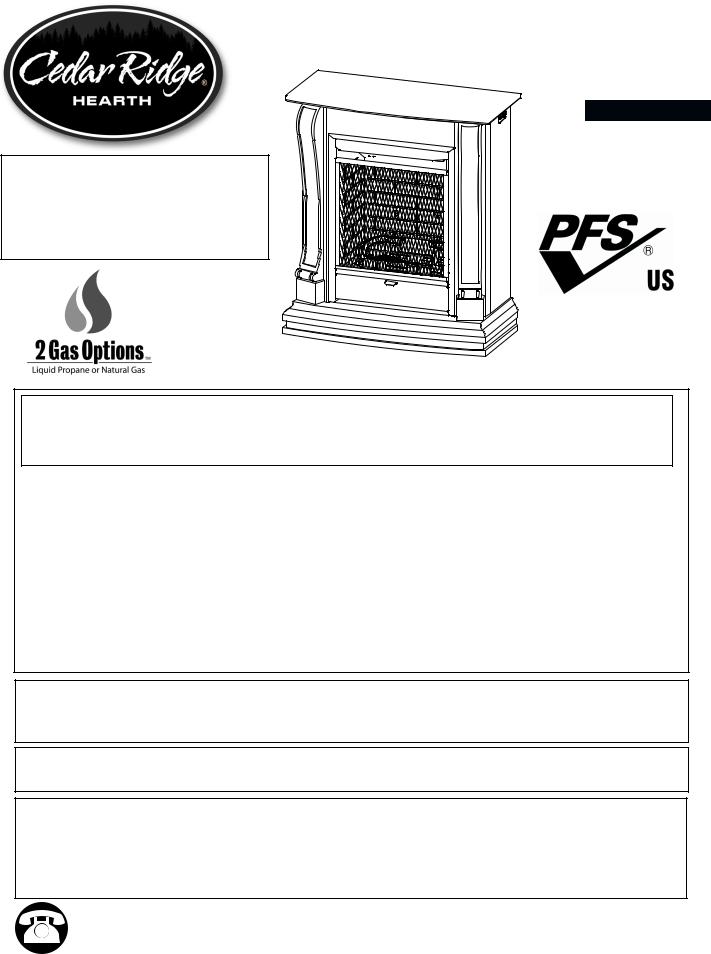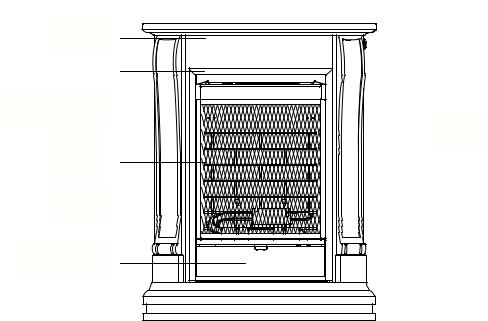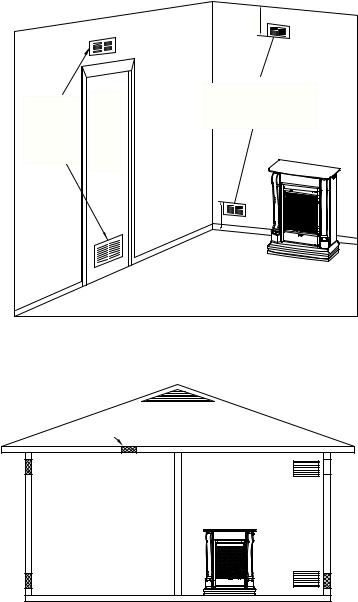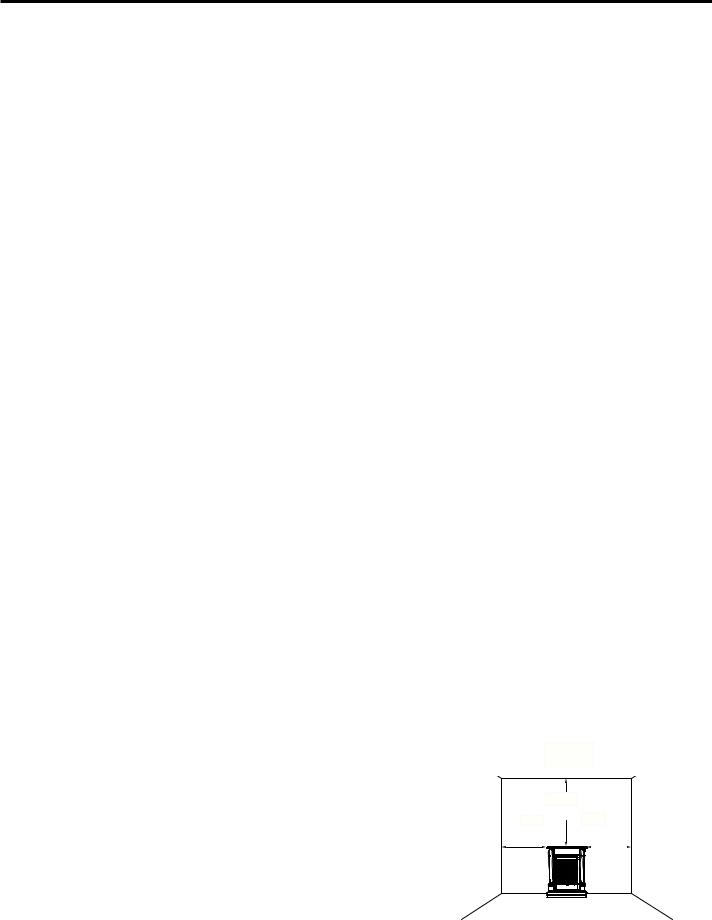Cedar Ridge Hearth CRHFV200DT User Manual

ITEM #0386389
VENT-FREE
COMPACT FIREPLACE
MODEL #CRHFV200DT
Español p. 36
WARNING: This appliance is equipped for (Natural and
Propane) gas. Field conversion is not permitted other than between natural or propane gases.
 CAUTION - FOR YOUR SAFETY
CAUTION - FOR YOUR SAFETY
 WARNING: IF THE INFORMATION IN THIS MANUAL IS NOT FOLLOWED EXACTLY, A FIRE OR EXPLOSION MAY RESULT CAUSING PROPERTY
WARNING: IF THE INFORMATION IN THIS MANUAL IS NOT FOLLOWED EXACTLY, A FIRE OR EXPLOSION MAY RESULT CAUSING PROPERTY
DAMAGE, PERSONAL INJURY, OR LOSS OF LIFE.
–Do not store or use gasoline or other flammable vapors and liquids in vicinity of this or any other appliance.
WHAT TO DO IF YOU SMELL GAS
• Do not try to light any appliance.
• Do not touch any electrical switch; do not use any phone in your building.
• Immediately call your gas supplier from a neighbor’s phone. Follow the gas supplier’s instructions.
• If you cannot reach your gas supplier, call the fire department.
–Installation and service must be performed by a qualified installer, service agency
or the gas supplier.
This is an unvented gas-fired heater. It uses air (oxygen) from the room in which it is installed. Provisions for adequate combustion and ventilation air must be provided. Refer to Air For Combustion and Ventilation section on page 8 of this manual.
INSTALLER: Leave this manual with the appliance. CONSUMER: Retain this manual for future reference.
This appliance may be installed in an aftermarket, permanently located manufactured (mobile) home, where not prohibited by local codes. This appliance is only for use with propane or natural gas. This appliance is equipped with a simple means to switch between propane and natural gas. Field conversion by any other means including the use of a kit is not permitted.
Questions, problems, missing parts? Before returning to your retailer, call our customer service department at 1-866-573-0674, 8:00 a.m - 4:30 p.m., EST,
Monday - Friday or e-mail customerservice@usaprocom.com.
LS-FV200DT2651M-1203

TABLE OF CONTENTS |
|
Safety Information.......................................................................................................................... |
3 |
Product Features............................................................................................................................ |
6 |
Air For Combustion and Ventilation................................................................................................ |
8 |
Installation .................................................................................................................................... |
11 |
Installing Logs............................................................................................................................... |
17 |
Operation...................................................................................................................................... |
18 |
Care and Maintenance................................................................................................................. |
24 |
Troubleshooting............................................................................................................................ |
26 |
Replacement Parts....................................................................................................................... |
29 |
 WARNING: Read the installation & operation instructions before using this appliance.
WARNING: Read the installation & operation instructions before using this appliance.
IMPORTANT: Read instructions and warnings carefully before starting installation. Failure to follow these instructions may result in a possible fire hazard and will void the warranty.
PRODUCT SPECIFICATIONS
ITEM #0386389 |
VENT FREE GAS FIREPLACE SYSTEM |
||
Input Max. |
20,000 BTU/Hr |
|
20,000 BTU/Hr |
Input Min. |
12,000 BTU/Hr |
|
16,500 BTU/Hr |
Electric BTU (available) |
5,120 |
|
5,120 |
Gas Type |
Natural |
|
LP/Propane |
Ignition |
Automatic Electronic |
|
Automatic Electronic |
|
Piezo Ignition |
|
Piezo Ignition |
Manifold Pressure |
4 in.W.C. |
|
9 in.W.C. |
Inlet Gas Pressure (*For purpose of inlet adjustment) |
|
||
Maximum |
10.5 in. |
|
14 in. |
Minimum |
5 in. |
|
11 in. |
Voltage |
120 VAC, 60 Hz |
|
|
Power |
1500 Watts |
|
|
Dimension, inches (H x W x D) |
|
||
Heater |
37.48 in. x 29.13 in. x 14.55 in. |
||
Carton |
40.94 in. x 32.67 in. x 18.31 in. |
||
Weight, lbs. |
|
|
|
Stove |
100 |
|
|
Shipping |
112 |
|
|
2

SAFETY INFORMATION
IMPORTANT: Read this owner’s manual carefully and completely before trying to assemble, operate, or service this heater. Improper use of this heater can cause serious injury or death from burns, fire, explosion, electrical shock, and carbon monoxide poisoning.
Only a qualified installer, service agent, or local gas supplier may install and service this product.
 WARNING: Do not store or use gasoline or other flammable vapors or liquids in the vicinity of this or any other appliance.
WARNING: Do not store or use gasoline or other flammable vapors or liquids in the vicinity of this or any other appliance.
 WARNING: This appliance can be used with propane or natural gas. It is shipped from the factory adjusted for use with propane.
WARNING: This appliance can be used with propane or natural gas. It is shipped from the factory adjusted for use with propane.
CARBON MONOXIDE POISONING: Early signs of carbon monoxide poisoning resemble the flu with headaches, dizziness, or nausea. If you have these signs, the heater may not be working properly. Get fresh air immediately! Have heater serviced. Some people are more affected by carbon monoxide than others. These include pregnant women, people with heart or lung disease, people who are anemic, those under the influence of alcohol, and those living in high altitudes.
NATURAL AND PROPANE/LP GAS: Natural and Propane/LP gases are odorless. An odormaking agent is added to the gas. The odor helps you detect a gas leak. However, the odor added to the gas can fade. Gas may be present even though no odor exists. Make certain you read and understand all warnings. Keep this manual for reference. It is your guide to operating this heater safely.
 WARNING: Any change to this fireplace or its controls can be dangerous.
WARNING: Any change to this fireplace or its controls can be dangerous.
 WARNING: Do not allow fans to blow directly into fireplace. Avoid any drafts that alter burner flame patterns.
WARNING: Do not allow fans to blow directly into fireplace. Avoid any drafts that alter burner flame patterns.
 WARNING: Do not use a blower insert, heat exchange insert or other accessory not approved for use with this heater.
WARNING: Do not use a blower insert, heat exchange insert or other accessory not approved for use with this heater.
Due to high temperatures, the appliance should be located out of traffic and away from furniture and draperies. Do not place clothing or other flammable material on or near the appliance. Never place any objects in the heater. Heater becomes very hot when running heater. Keep children and adults away from hot surfaces to avoid burns or clothing ignition. Fireplace will remain hot for a time after shutdown. Allow surfaces to cool before touching. Carefully supervise young children when they are in the room with the heater.
3
1.Do not place Propane/LP supply tank(s) inside any structure. Propane/LP supply tank(s) must be placed outdoors.
2.This heater needs fresh air ventilation to run properly. This heater has an Oxygen Depletion Sensing (ODS) safety shut-off system. The ODS shuts down the heater if not enough fresh air is available. See Air for Combustion and Ventilation, pages 8 through 10. If heater keeps shutting off, see Troubleshooting, pages 26 through 28.
3.Keep all air openings in front and bottom of heater clear and free of debris. This will ensure enough air for proper combustion.
4.If heater shuts off, do not relight until you provide fresh, outside air. If heater keeps shutting off, have it serviced.
5.Do not run heater:
•Where flammable liquids or vapors are used or stored.
•Under dusty conditions.
6.Before using furniture polish, wax, carpet cleaner, or similar products, turn heater off. If heated, the vapors from these products may create a white powder residue within burner box or on adjacent walls or furniture.
7.Do not use heater if any part has been under water. Immediately call a qualified service technician to inspect the heater and to replace any part of the control system and
any gas control which has been under water.
8.Turn off and unplug heater and let cool before servicing. Only a qualified service person should service and repair heater.
9.Operating heater above elevations of 4,500 ft. could cause pilot outage.
10.To prevent performance problems, do not use propane/LP fuel tank of less than 100 lb. capacity.
11.This heater should not be installed in a bedroom or bathroom.
12.Do not use this heater as a wood-burning heater. Use only the logs provided with the heater.
13.To prevent sooting, follow the instructions in Care and Maintenance (page 24).
14.Do not add extra logs or ornaments such as pine cones, vermiculite, or rock wool. Using these added items can cause sooting. Do not add lava rock around base. Rock and debris could fall into the control area of heater. After servicing, always replace screen before operating heater.
15.This heater is designed to be smokeless. If logs ever appear to smoke, turn off heater and call a qualified service person. Note: During initial operation, slight smoking could occur due to log curing and the heater burning manufacturing residues.
ELECTRICAL SAFETY INFORMATION - IMPORTANT INSTRUCTIONS
When using electrical appliances, basic precautions should always be followed to reduce the risk of fire, electric shock, and injury to persons, including the following:
1.Read all instructions before using this heater.
2.This appliance is hot when in use. To avoid burns, do not come in contact with heater. Keep combustible materials, such as furniture, pillows, bedding, papers, clothes, and cur tains at least 3 feet (1m.) from the front of the heater, and keep them away from the sides and rear.
4
3.Extreme caution is necessary when any heater is used by or near children or invalids and whenever the heater is left operating and unattended.
4.Do not operate any heater with a damaged cord or plug or if the heater malfunc tions, has been dropped or damaged in any manner. Have heater repaired by an qualified service person.
5.Under no circumstances should this electric fireplace be modified. Parts having to be re moved for servicing must be replaced prior to operating this electric fireplace again.
6.Do not use outdoors.
7.This heater is not intended for use in bathrooms, laundry areas or similar indoor locations. Never use this appliance near a bathtub or other water container.
8.Do not run cord under carpeting. Do not cover cord with throw rugs, runners or similar coverings. Arrange cord away from traffic areas and where it will not be tripped over.
9.To disconnect heater, turn controls to OFF, then remove plug from outlet.
10.Connect to properly grounded outlets only.
11.When this appliance is installed, it must be electrically grounded in accordance with local codes with the current CSA C22.1 Canadian local codes for USA installations. Follow local codes and National Electrical Code, ANSI/NFPA NO.70 and Canadian Cord: C 22.2 NO.0.
12.Do not insert or allow foreign objects to enter any ventilation or exhaust opening as this may cause electric shock, fire or damage to the heater.
13.To prevent a possible fire, do not block air intakes or exhaust in any manner. Do not use on soft surfaces, such as a bed, where openings may become blocked.
14.This heater gets hot and it contains internal parts that sparks and arcs. Do not use it in areas where gasoline, paint, or flammable liquids are used or stored.
15.Use this heater only as described in this manual. Other uses not recommended by the manufacturer may cause fire, electric shock, or injury.
16.Avoid the use of an extension cord because it may overheat and cause a risk of fire. However if you must use an extension cord, the cord shall be No. 14AWG minimum size and rated not less than 1900 watt. The extension cord must be a three wire cord with grounding type plug and cord connector.
17.This electric fireplace heater should not be used as a drying rack for clothing. Also, do not hang Christmas stockings or decorations on or near it.
QUALIFIED INSTALLING AGENCY
Only a qualified agency should perform installation and replacement of gas piping, gas utilization equipment or accessories, and repair and servicing of equipment. The term “qualified agency” means any individual, firm, corporation, or company that either in person or through a representative is engaged in and is responsible for:
a)Installing, testing, or replacing gas piping or
b)Connecting, installing, testing, repairing, or servicing equipment; that is experienced in such work; that is familiar with all precautions required; and that has complied with all the requirement of the authority having jurisdiction.
5

PRODUCT FEATURES
SAFETY PILOT
This heater has a pilot with an Oxygen Depletion Sensing (ODS) safety shutoff system. The ODS/pilot shuts off the heater if there is not enough fresh air.
PIEZO IGNITION SYSTEM
This heater is equipped with an electronic piezo control system. This system requires AAA batteries (provided).
THERMOSTAT HEAT CONTROL
The control automatically cycles the burner on and off to maintain a desired room temperature. See page 19.
2 GAS OPTIONS CAPABLE
Your heater is equipped to operate on either propane or natural gas. The heater is shipped from the factory ready for connecting to propane. The heater can easily be changed to natural gas by having your qualified installer follow the instructions on page
14 and the markings on the heater.
State of Massachusetts: The installation must be made by a licensed plumber or gas fitter in the Commonwealth of Massachusetts. Sellers of unvented propane or natural gasfired supplemental room heaters shall provide to each purchaser a copy of 527 CMR 30 upon sale of the unit.
In the State of Massachusetts, unvented propane or natural gas-fired space heaters shall be prohibited in bedrooms and bathrooms.
In the State of Massachusetts the gas cock must be a T-handle type. The State of Massachusetts requires that a flexible appliance connector cannot exceed three feet in length.
LOCAL CODES
Install and use heater with care. Follow all codes. In the absence of local codes, use the latest edition of The National Fuel Gas Code, ANSI Z223.1, also known as NFPA 54*.
*Available from: |
|
American National Standard Institute, Inc |
National Fire Protection Association, Inc. |
1430 Broadway |
1 Batterymarch Park |
New York, NY 10018 |
Quincy, MA 02269-9101 |
This heater is designed for vent-free operation. State and local codes in some areas prohibit the use of vent-free heaters.
6

UNPACKING
1.Remove top inner pack.
2.Tilt carton so that heater is upright.
3.Remove protective side packaging.
4.Slide heater out of carton.
5.Remove protective plastic wrap.
6.Remove screws on the top of the screen
7.Hold the screen, lift, and pull forward.
8.Remove log set by cutting plastic ties.
9.Carefully unwrap log.
10.Check for any shipping damage. If heater or log is damaged, promptly inform your dealer where you bought the heater.
PRODUCT IDENTIFICATION
Fig. 1
Mantel |
Decorative Frame |
Screen |
Heater Controls |
(Behind Door) |
WATER VAPOR: A BY-PRODUCT OF UNVENTED ROOM HEATERS
Water vapor is a by-product of gas combustion. An unvented room heater produces approximately one (1) ounce (30 mL) of water for every 1,000 BTUs (.3 kw) of gas input per hour. An unvented room heater is recommended as a supplemental heater (a room) rather than a primary heat source (an entire house). In most supplemental heat applications, the water vapor does not create a problem. In most applications, the water vapor enhances the low humidity atmosphere experienced during cold weather.
The following steps will help ensure that water vapor does not become a problem:
1.Be sure the heater is the proper size for the application, including adequate combustion air and circulation air.
2.If there is high humidity, a dehumidifier may be used to help lower the water vapor content of the air.
3.Do not use an unvented room heater as the primary heat source.
7

AIR FOR COMBUSTION AND VENTILATION
 WARNING: If the area in which the heater may be operated does not meet the required volume for indoor combustion air, combustion and ventilation air shall be provided
WARNING: If the area in which the heater may be operated does not meet the required volume for indoor combustion air, combustion and ventilation air shall be provided
by one of the methods described in the National Fuel Gas Code, ANSI Z223.1/NFPA 54, the International Fuel Gas Code, or applicable local codes.
PRODUCING ADEQUATE VENTILATION
All spaces in homes fall into one of the three following ventilation classifications:
1.Unusually Tight Construction
2.Unconfined Space
3.Confined Space
The information on pages 8 through 10 will help you classify your space and provide adequate ventilation.
Confined and Unconfined Space
A confined space is a space whose volume is less than 50 cu. ft. per 1,000 BTU/hr (4.8 m^3 per kw) of the aggregate input rating of all appliances installed in that space and an unconfining space as a space whose volume is not less than 50 cu. ft. per 1,000 BTU/hr (4.8 m^3 per kw) of the aggregate input rating of all appliances installed in that space. Rooms connecting directly with the space in which the appliances are installed*, through openings not
furnished with doors, are considered a part of the unconfined space.
This heater shall not be installed in a confined space or unusually tight construction unless provisions are provided for adequate combustion and ventilation air.
*Adjoining rooms are connecting only if there are doorless passageways or ventilation grills between them
Unusually Tight Construction
The air that leaks around doors and windows may provide enough fresh air for combustion and ventilation. However, in buildings of unusually tight construction, you must provide additional fresh air.
Unusually tight construction is defined as construction where:
a)walls and ceilings exposed to the outside atmosphere have a continuous water vapor retarder with a rating of one perm (6x10-11kg per pa-sec-m2) or less with openings gasketed or sealed and
b)weather stripping has been added on windows that can be opened and on doors and
c)caulking or sealants are applied to areas such as joints around window and door frames, between sole plates and floors, between wall-ceiling joints, between wall panels, at
penetrations for plumbing, electrical, and gas lines, and at other openings.
If your home meets all of the three criteria above, you must provide additional fresh air.
See “Ventilation Air From Outdoors” (page 10). If your home does not meet all of the three criteria above, proceed to “Determining Fresh-Air Flow For Heater Location”.
8
DETERMINING FRESH-AIR FLOW FOR HEATER LOCATION
Determining if You Have a Confined or Unconfined Space
Use this worksheet to determine if you have a confined or unconfined space.
Space: Includes the room in which you will install heater plus any adjoining rooms with door-less passageways or ventilation grills between the rooms.
1.Determine the volume of the space Length × Width × Height = cu. ft. (volume of space)
Example: Space size 20 ft. (length) × 16 ft.(width) × 8 ft. (ceiling height) = 2560 cu. ft.
(volume of space)
If additional ventilation to adjoining room is supplied with grills or openings, add the volume of these rooms to the total volume of the space.
2.Divide the space volume by 50 cu. ft. to determine the maximum BTU/hr the space can support.
_______ (volume of space) ÷ 50 cu. ft.= (Maximum BTU/hr the space can support)
Example: 2560 cu. ft. (volume of space) ÷ 50 cu. ft. = 51.2 or 51,200 (maximum BTU/hr the space can support)
3.Add the BTU/hr of all fuel burning appliances in the space. Vent-free heater ________ BTU/hr
Gas water heater* _______BTU/hr
Gas furnace ___________ BTU/hr |
|
|
|
Vented gas heater _______BTU/hr |
Example: |
|
|
Gas heater logs ________ BTU/hr |
Gas water heater |
30,000 BTU/hr |
|
Other gas appliances*+ ___BTU/hr |
Vent-free heater + |
26,000 BTU/hr |
|
Total =________________ BTU/hr |
Total |
= |
56,000 BTU/hr |
*Do not include direct-vent gas appliances. Direct-vent draws combustion air from the outdoors and vents to the outdoors.
4.Compare the maximum BTU/hr the space can support with the actual amount of BTU/hr used.
_______ BTU/hr (maximum the space can support)
_______ BTU/hr (actual amount of BTU/hr used). Example : 51,200 BTU/hr (maximum the space can support)
56,000 BTU/hr (actual amount of BTU/hr used)
The space in the above example is a confined space because the actual BTU/hr used is more than the maximum BTU/hr the space can support.
You must provide additional fresh air. Your options are as follows:
a)Rework worksheet, adding the space of an adjoining room. If the extra space provides an unconfined space, remove door to adjoining room or add ventilation grills between rooms. See “Ventilation Air From Inside Building,” page 10.
b)Vent room directly to the outdoors. See “Ventilation Air From Outdoors”, page 10.
c)Install a lower BTU/hr heater if lower BTU/hr size makes room unconfined. If the actual BTU/hr used is less than the maximum BTU/hr the space can support, the space is an unconfined space. You will need no additional fresh air ventilation.
9

 WARNING: If the area in which the heater may be operated does not meet the required volume for indoor combustion air, combustion and ventilation air shall be provided by one of the methods described in the NATIONAL FUEL GAS CODE, ANSI Z223.1/NFPA 54, the
WARNING: If the area in which the heater may be operated does not meet the required volume for indoor combustion air, combustion and ventilation air shall be provided by one of the methods described in the NATIONAL FUEL GAS CODE, ANSI Z223.1/NFPA 54, the
INTERNATIONAL FUEL GAS CODE, or applicable local codes.
Ventilation Air From Inside Building
This fresh air would come from adjoining unconfined space. When ventilating to an adjoining unconfined space, you must provide two permanent openings: one within 12 in. of the wall connecting
the two spaces (see options 1 and 2,
Fig. 2). You can also remove door into adjoining room (see option 3, Fig. 2). Follow the National Fuel Gas Code NFPA 54/ANS Z223.1. Air for Combustion and Ventilation for required size of ventilation grills or ducts.
Ventilation Air From Outdoors
Provide extra fresh air by using ventilation grills or duct. You must provide two permanent openings: one within 12 in. of the ceiling and one within 12 in. of the floor. Connect these items directly to the outdoors or spaces open to the outdoors. These spaces include attics and crawl spaces. Follow the National Fuel Gas Code NFPA 54/ANS Z223.1. Air for Combustion and Ventilation for required size
of ventilation grills or ducts.
IMPORTANT: Do not provide openings for inlet or outlet air into attic if attic has a thermostat-controlled power vent. Heated air entering the attic will activate the power vent. Rework worksheet, adding the space of the adjoining unconfined space.
The combined spaces must have enough fresh air to supply all appliances in both spaces.
Fig. 2 - Ventilation Air from Inside Building
|
|
in. |
|
|
|
12 |
|
|
Or |
Ventilation Grills |
|
Ventilation |
Into adjoining Room, |
||
Remove |
|||
Grills |
Option 2 |
||
Door |
|||
Into Adjoining |
Into |
|
|
Room, |
Adjoining |
|
|
Option 1 |
Room, |
|
|
|
Option 3 |
|
|
|
|
in. |
|
|
|
12 |
Fig. 3 - Ventilation Air from Outdoors
Outlet |
Ventilated |
Attic |
|
Air |
|
Outlet |
|
Air |
To Attic |
|
|
|
To |
|
Crawl |
|
Space |
Inlet |
|
Air |
|
10

INSTALLATION
 NOTICE: This heater is intended for use as supplemental heat. Use this heater along with your primary heating system. Do not install this heater as your primary heat source. If you have a central heating system, you may run system’s circulating blower while using heater. This will help circulate the heat throughout the house.
NOTICE: This heater is intended for use as supplemental heat. Use this heater along with your primary heating system. Do not install this heater as your primary heat source. If you have a central heating system, you may run system’s circulating blower while using heater. This will help circulate the heat throughout the house.
 WARNING: A qualified technician must install heater. Follow all local codes.
WARNING: A qualified technician must install heater. Follow all local codes.
 WARNING: Never install the heater:
WARNING: Never install the heater:
•in a bedroom or bathroom
•in a recreational vehicle
•where curtains, furniture, clothing, or other flammable objects are less than 42 in. from the front, top or sides of the heater.
•in high traffic areas
•in windy or drafty areas
CAUTION: This heater creates warm air currents. These currents move heat to wall surfaces next to heater. Installing heater next to vinyl or cloth wall coverings or operating heater where impurities (such as tobacco smoke, aromatic candles, cleaning fluids, oil or kerosene lamps, etc.) in the air exist, may cause walls discolored.
WARNING: Maintain the minimum clearances. If you can, provide greater clearances from floor, ceiling and adjoining side and back walls.
IMPORTANT: Vent-free heaters add moisture to the air. Although this is beneficial, installing heater in rooms without enough ventilation air may cause mildew to form from too much moisture. See Air for Combustion and Ventilation, pages 8 through 10.
CHECK GAS TYPE
Use only the type of gas indicated on the plate. If your gas supply cannot meet that requirement, do not install heater.
CLEARANCES TO COMBUSTIBLES
Carefully follow the instructions below. This heater is a wall mount unit designed to sit directly on the floor or on a mantel base.
IMPORTANT: You must maintain minimum wall and ceiling clearances during installation. The minimum clearances are shown in Fig. 4. Measure from outermost point of heater.
Minimum Wall and Ceiling Clearances (see Fig. 4)
A.Clearances from outermost point of heater to any combustible side wall should not be less than 12 in.
B.Clearances from the heater to the ceiling should not be less than 48 in.
11
Fig. 4 - Minimum Clearance |
|
|
to Wall and Ceiling |
|
|
|
Ceiling |
|
|
48 in |
|
|
Minimum |
|
Side wall |
12 in |
Side wall |
12 in |
|
|
Minimum |
Minimum |
|
